Akira Academy
Akira Academy: Net Promoter Score
A lesson about NPS for restaurants. Learn what NPS is, how it's calculated specifically for restaurants, and what it looks like in Akira.
The key to your restaurant's success? Guest experience that leads to retention. In this Akira Academy lesson, you'll learn all about Net Promoter Score (NPS) and how it helps you understand and improve the guest experience.
What is a Net Promoter Score (NPS)?
A Net Promoter Score (NPS) is a measurement tool used to help restaurants understand guest satisfaction in order to predict and improve customer retention.
Net Promoter Scores use a single question to measure the likelihood of a customer recommending your restaurant:
"On a scale from 1-10, how likely are you to recommend our restaurant to your family & friends?"
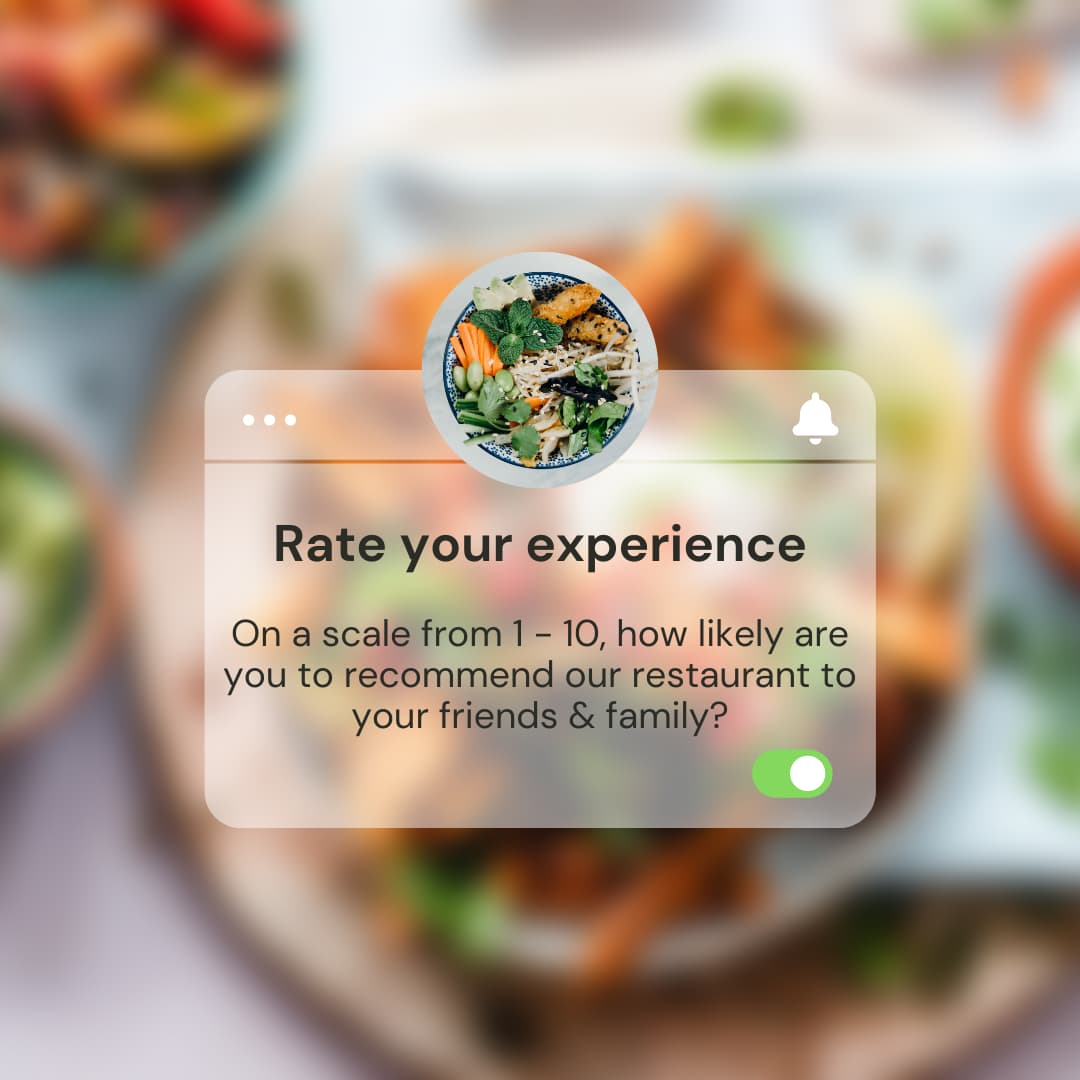
Created by Bain & Company in 2003, Net Promoter Score has been the gold standard for companies to understand customer sentiment and predict retention.
Today, many restaurants have turned to NPS for the same reason—to understand guest satisfaction.
How can you calculate your restaurant's NPS?
Restaurants looking to calculate their Net Promoter Score need to get guests to answer the NPS question after their visit:
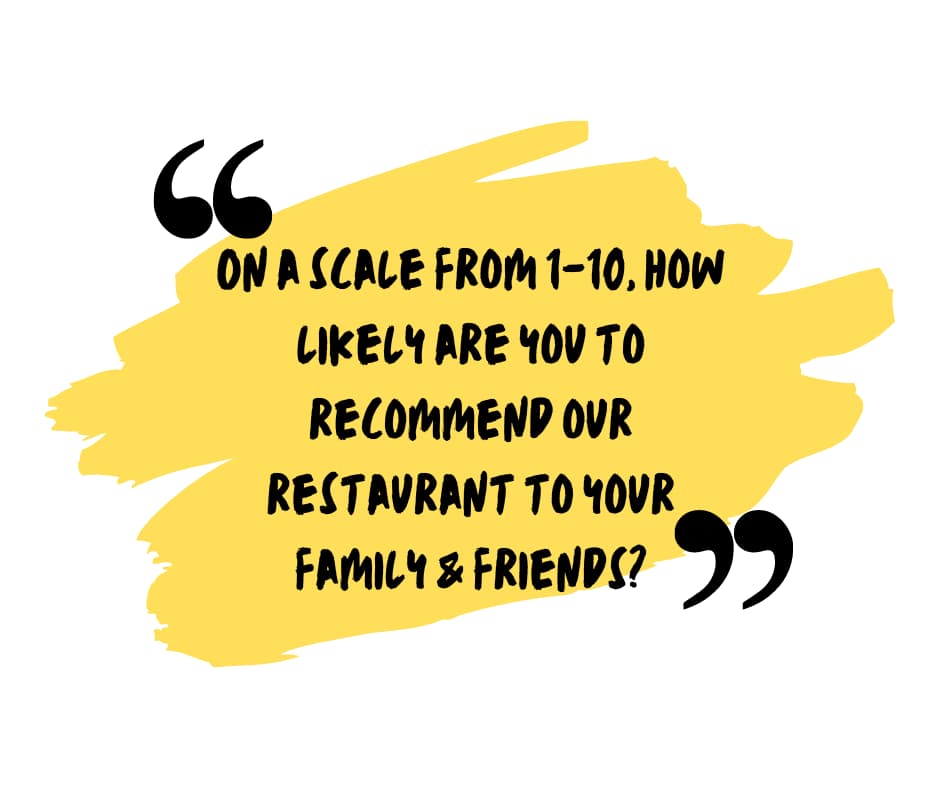
They select one number between 1-10 as their response, with 0 being 'not likely at all' and 10 being 'extremely likely'.
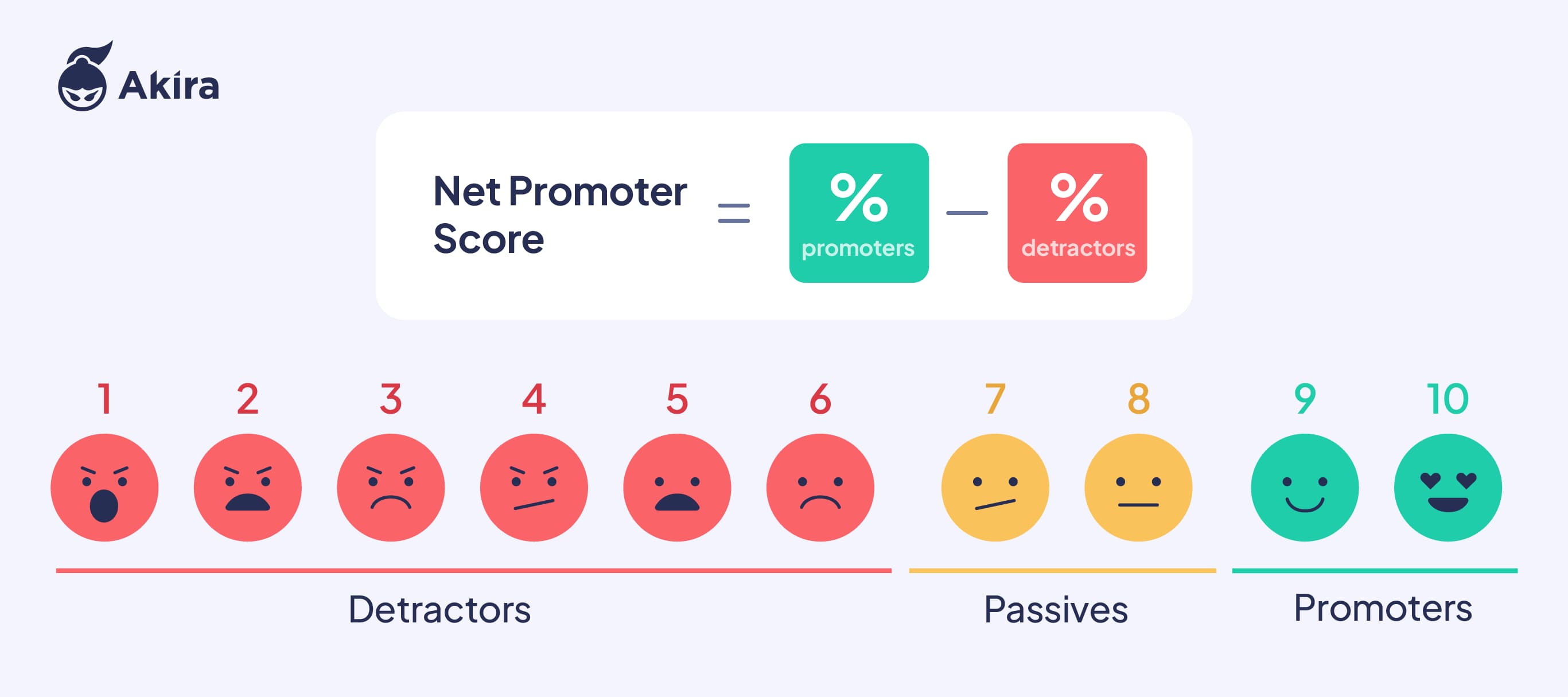
Depending on their numerical response, guests are then put into one of the 3 categories:
- Detractors: Guests with a response of 1 to 6. These are unhappy customers who had a bad experience and are unlikely to dine with you again.
- Passives: Guests with a response of 7 or 8. These guests were satisfied enough with their visit, but indifferent towards your restaurant.
- Promoters: Guests with a response of 9 or 10. These are your loyal patriots who are most likely to promote your restaurant to family and friends.
Once each respondent is categorized, you then can calculate the NPS of your restaurant using the following equation:
% OF PROMOTERS - % OF DETRACTORS = NET PROMOTER SCORE
What is a good NPS sample size for restaurants?
As with any calculation, it's only as good as the data you have. The same logic applies to NPS. With any survey calculation, there are things you can do to ensure your NPS restaurant score is as accurate as possible:
Number of responses matter
Your restaurant's NPS is impacted by the number of responses.
To simply explain, picture this. Only two guests respond to your restaurant's NPS survey and one rates you a "1" and the other a "10". That's not going to give you an accurate depiction of guest sentiment, since it's only 2 guests out of hundreds.
The more responses to your NPS survey, the more accurate it will be for predicting sentiment.
Sample size guidelines for NPS Score
According to Qualtrics, a best-in-class rule of thumb for NPS sample size is 1200 customers, accounting for a 5% margin of error.
But restaurants have a unique situation. Many companies send out an NPS survey to a large number of customers all at once, where restaurants survey their guests after their visit.
Don't stress if you don't have 1200 right off the bat. It will take time to grow your NPS base, and the below will help guide you towards NPS data excellence:
- Strive for a diverse set of customers to capture the true sentiment across a wide range of guests.
- Unlike other NPS surveys, it's ok to survey a guest after each visit—as their sentiment may change.
How does NPS work in Akira?
At Akira, we recognize that the feedback you receive in the restaurant industry is much more fluid. And the way you calculate Net Promoter Scores need to adapt accordingly based on the following realities:
- Ongoing feedback: A traditional NPS survey will happen 1-2x per year in other industries. In restaurants? The feedback never stops, and understanding how a guest's sentiment varies between visits is essential to improving.
- Feedback that isn't numerical: Other than restaurant ratings (how many stars), feedback isn't numerical, but it's critical to optimizing guest experience and understanding sentiment.
- A combination of feedback and ratings: It's impossible for restaurants to get their feedback down to one survey. Guests leave feedback and reviews in many different places, both online and offline.
- 1-5 scale versus 1-10 scale: Restaurant ratings (how many stars, etc.) are 1-5, not 1-10.
The Akira AI Difference
As mentioned above, the way the restaurant industry gathers feedback is unique to other industries, and this needs to be taken into consideration when forming an NPS.
Asking guests to rate their restaurant experience from 1-10 is not typical. What is typical is:
- Direct feedback (email, phone call, website form, etc.)
- Online reviews (Yelp, TripAdvisor, Toast, Facebook, etc.)
Direct feedback is in written format, not a score. Reviews are scored 1-5 stars, and usually include a written element.
How Akira Engineers NPS for restaurants
Akira uses AI to normalize all of your direct feedback and online reviews into a single accurate restaurant Net Promoter Scorecard:
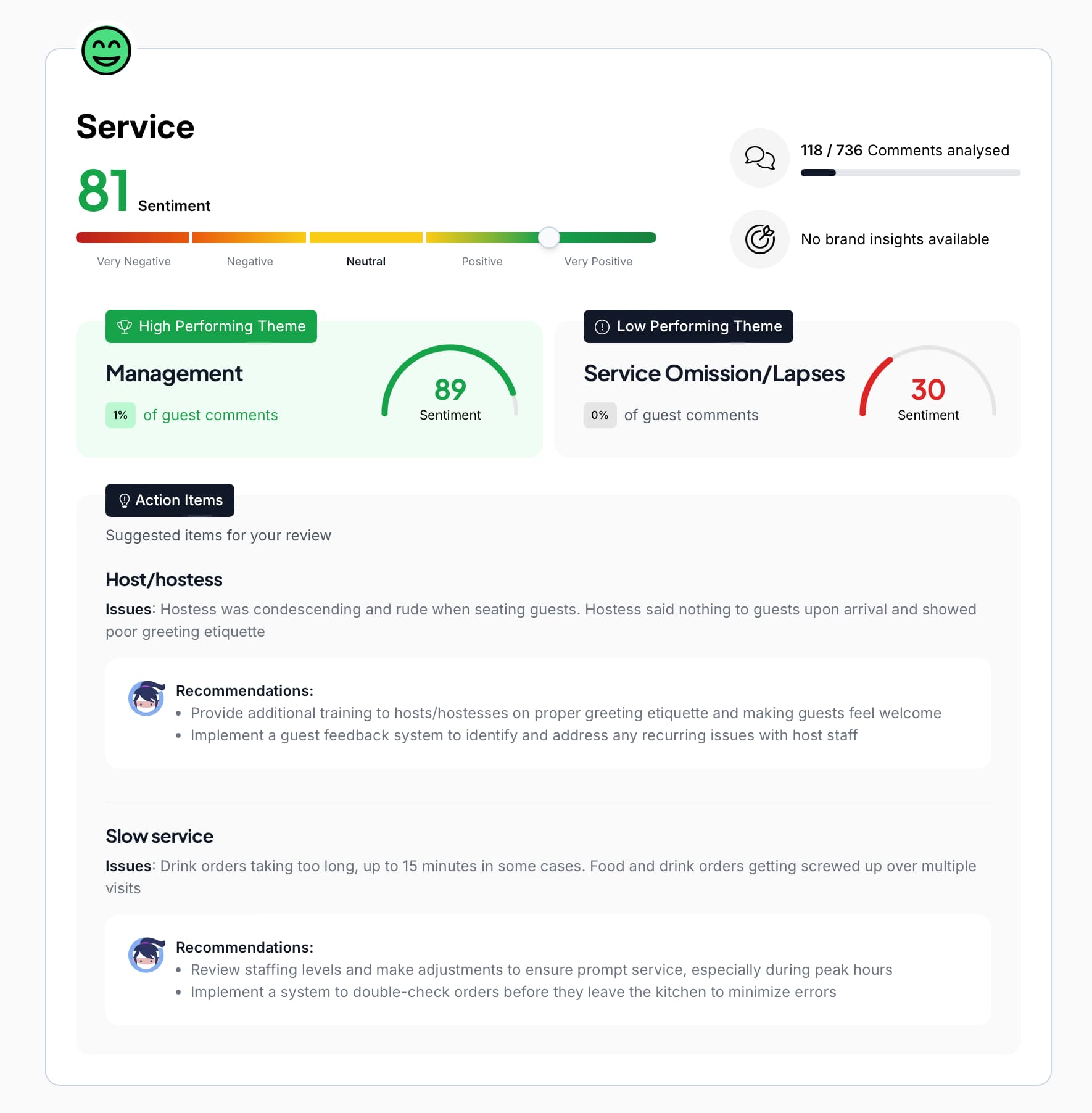
Akira provides a snapshot of your current NPS, and whether it's trending up or down.
Because of the way feedback and reviews are collected for restaurants, Akira uses a scale ranging from "Very Negative" to "Very Positive" for NPS.
It then uses AI to understand the sentiment of each piece of feedback or online review, and gives it a score to categorize it into one of the 5 scale options:
- Very Negative
- Negative
- Neutral
- Positive
- Very Positive
Turning NPS into Insight
Knowing your NPS is only useful if you understand what's driving it. This is why Akira expands NPS to a full scorecard with the following actionable insights:
- Biggest Win: Something guests mention over and over as a positive.
- Top Concern: A negative comment that's trending within feedback/reviews.
- Suggestions: Insights to improve based on trends pulled from feedback.
Other things Akira's NPS scorecard takes into consideration include:
- Amount of analyzed feedback: If you have a low amount of feedback, it can skew your score. Keep this in mind when reviewing.
- Positive scores with negative feedback: Our team at Akira believes if you have generally good scoring but negative written feedback, something isn't quite right—and this will impact your NPS.
The storytelling component of Akira's NPS is a gamechanger for restaurants. See not only where you stand, but what you need to do to improve.
Benchmarks: What is a good NPS score?
Benchmarking is key to improving. But when it comes to NPS scores for restaurants, benchmarking can be tricky. The reason being (as explored in the above sections), is the way you calculate NPS is far more nuanced.
Qualtrics did some research and determined that a good benchmark for the fast food industry was 24:
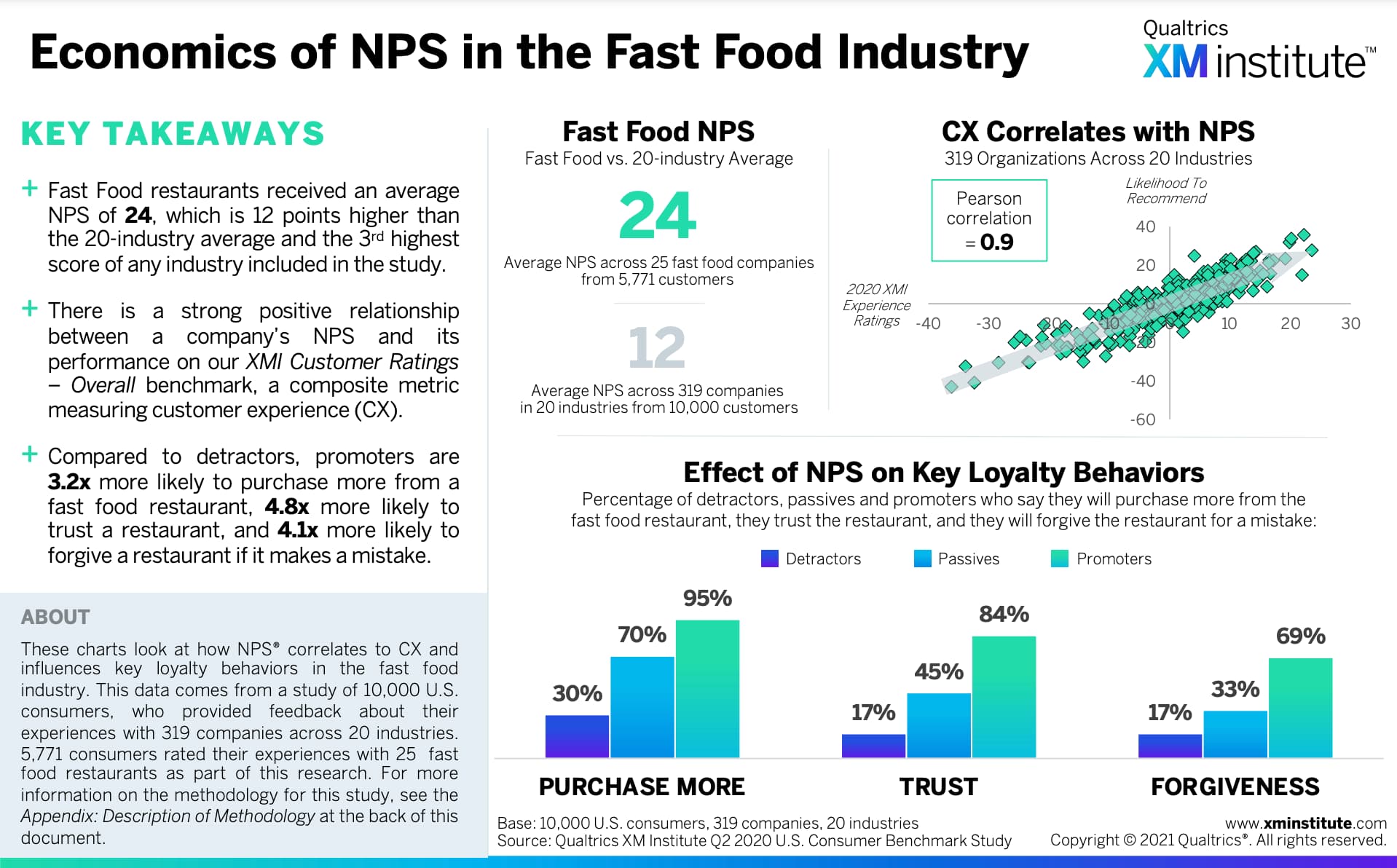
This benchmarking score is IF you use the traditional NPS methodology.
What's a Good NPS in Akira?
Akira's goal is to take the guesswork out of NPS for restaurants. Using reverse engineering and AI to help, we use your direct feedback and online reviews to create the following scale:
- 1-20: Very Negative
- 20-40: Negative
- 40-60: Neutral
- 60-80: Positive
- 80-100: Very Positive
Easily see exactly where you stand. And for restaurants with multiple locations, start to see key performance indicators (KPIs) that will help you accurately determine your restaurants' unique NPS benchmark.
4 Quick wins to improving NPS
Now that you understand the basics surrounding NPS, it's time to get tactical. The point of an NPS is to understand where you stand with customers, so that you can improve.
Below are 5 quick tactical wins to improving NPS:
-
Have a benchmarking system in place
A major problem that many restaurants have today is the inability to gain actionable insights. This is because they don't have a benchmarking system in place, so are forced to be reactive instead of proactive.
An online reputation management system like Akira helps you lay the foundation for reputation management by giving you a holistic view of your feedback, online reviews, and listings and an easy way to manage them. Akira also provides the NPS scorecard with actionable insights on exactly how to improve.
Having a benchmarking system in place is essential to improving guest experience and customer retention, so make sure you set the foundation today.
-
Respond to every piece of feedback and all reviews
In order to boost customer retention and online reputation management, you need a plan in place to respond to direct feedback and online reviews.
As our team at Akira likes to say, "don't ghost your guests". Not responding is a surefire way to lose them forever, when you could have easily resolved their issue. Mistakes happen, it's how you handle them that matters.
Here's a step-by-step guide to responding to Google Reviews, and a lot of it also applies to managing direct feedback.
-
Use feedback to improve guest relations & experience
Soliciting feedback is half the equation, and the other half is doing something with it. The problem is that for many restaurants, there's no organized, holistic view to reveal the problem areas.
Akira's NPS scorecard is designed to tell a visual story of how your restaurant's sentiment is faring and where you need to focus efforts to improve. From there, you can begin taking steps to optimizing guest experience.
-
Train staff to encourage frequent direct feedback
You can only fix the problems you know about, which is why having a strategy in place to collect direct feedback and online reviews is essential.
Since direct feedback is preferred to solve issues privately, the easier you make it, the better. Below are a few ways to encourage feedback:
- Simply ask each guest if they’d consider providing their feedback
- Include QR codes on receipts that link to an easy survey
- Email or text messages
- Through your mobile app
At the end of the day, the more feedback and reviews you can encourage from guests, the more accurate your NPS will be. And from there, you can put a plan in place to respond and improve.